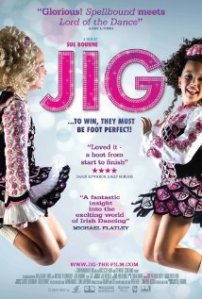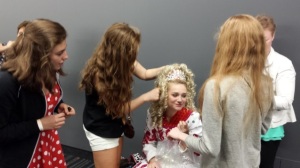I recently spent five days surrounded by incredibly talented kids covered in fake tan, wigs, and Swarovski crystals. I realize this reads like an oxymoron, but for those of you who are familiar with Irish dance, you’re probably not surprised. See, the event I’m talking about is the North American Irish Dance Championships, this year held in Montreal, Canada. Over 2,000 Irish dancers from age 7 to adult danced in both team and solo competitions.
This year, my sister and I were two of these dancers. I competed in the Under 17 B group along with 140 other girls, while Fiona, my sister, was in the Under 13 B group. Our school, Tara Academy of Irish Dance sent 8 dancers, all in the solo competition. Solo dancing competitions involve two to three dances, each judged by three well-trained and well-respected adjudicators.
The first of the dances is danced in hard shoes (which are like tap shoes, but made out of leather with fiberglass tips and heels.) This dance is all about rhythm, and dancers try to make the most complex sounds as they can. The next dance, a soft-shoe dance, is danced in what are basically black leather ballet slippers. It is much more balletic than the first dance, with lots of high jumps and kicks. Dancers appear to fly around the stage.
After that, the best half is “recalled” to do a third dance, which is hard shoe again, and danced alone, as a showcase dance. The entire competition takes hours—mine started at 8 a.m., and we didn’t hear recalls until 3:30. Talking (or as I am now, writing) about Irish dance is all about keeping a balance between what dancers all know and accept is part of the pageantry—the costumes that cost thousands of dollars, wigs, tans, make-up—and the training, which is anything but glamorous. The training includes dripping in sweat, struggling to breathe and holding dance shoes together with duct tape. In this world, there are broken bones, hurt ankles and torn muscles. It teaches dancers what many would consider the important lessons in life: how to refuse to give up, how important friends and family are, and how valuable hard work is.
But no young dancer dreams of doing another full treble jig or more drills. Instead, little girls look up to us “big girls” in our sparkly dresses, and dream. They dream of their own sparkly dresses, how their hair will look. This glamour teaches us how to dream and the training teaches us how to work. You can’t separate the two, and even if you did, it wouldn’t be same. Like it or not (and there are many who protest the more ridiculous elements of Irish dance fashion), the glamour, just like the athleticism, is here to stay.
If you are interested in learning more about Irish dancing, particularly competitive Irish dancing I can recommend the following:
 Jig is a documentary I couldn’t love more. Famous within the Irish dance world for correctly and beautifully showing Irish dancers training for and performing at the 2011 World Irish Dancing Championships, it includes both solo and team dancers from all over the world.
Jig is a documentary I couldn’t love more. Famous within the Irish dance world for correctly and beautifully showing Irish dancers training for and performing at the 2011 World Irish Dancing Championships, it includes both solo and team dancers from all over the world.
The Best of Riverdance is the DVD form of the much-loved stage show that revolutionized Irish dancing by making it popular, appealing and elegant. It inspired and encouraged many (including me) to dance, and remains what my sister and I turn on when we feel discouraged.
For more educational materials about Irish dancing I recommend The Complete Guide to Irish Dances, Discoveries–Ireland, and for a younger audience Irish Step Dancing. Happy dancing!
